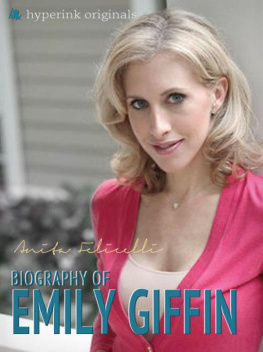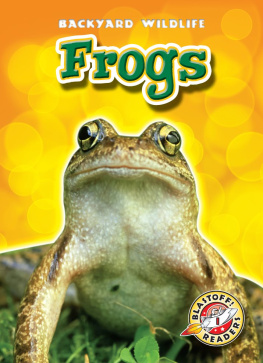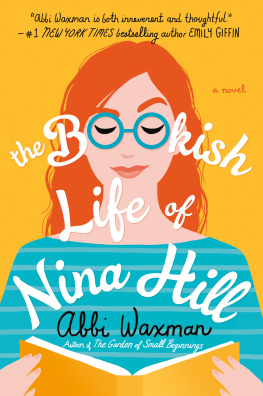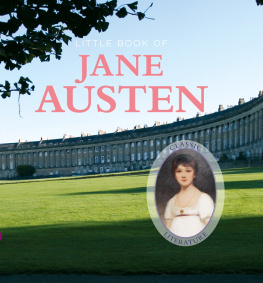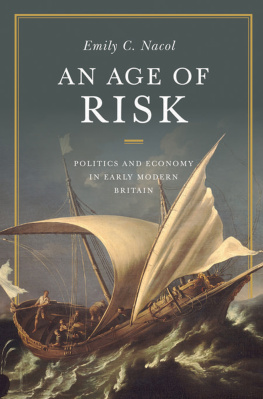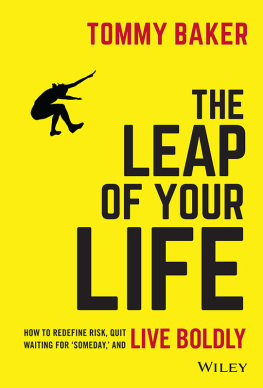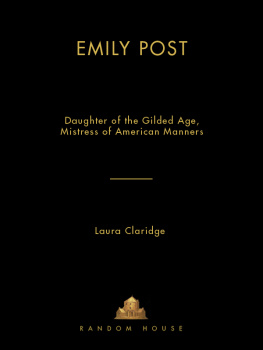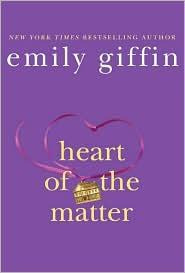Emily Giffin: A Biography
I.
Emily Giffin: A Biography
Introduction
Dubbed a modern-day Jane Austen, Emily Giffins five novels have sold millions of copies and scored spots on the New York Times bestseller list. Blonde, blue-eyed, smart, and beautiful, Giffin writes about heroines with deep flaws that drive the story, but on the surface at least, Giffins own life seems charmed, even close to perfect.
After years of making the smart, risk-averse decisions that often mark overachievers, Giffin took a major leap of faith in herself, leaving the stressful world of high-stakes litigation to try writing novels full-time. For many lawyers, following their dreams would have been too risky. For many lawyers that do take a risk, the leap would have been a mere break that led to returning to legal practice. But not for Emily Giffin, whose risk paid off with enormous measurable success and the adoration of her fans.
Like Jane Austen, Giffins novels plumb the depths of human relationships, especially friendships and marriage. Unlike Austens novels, Giffins novels are marketed as chick-lit, a term that is often employed to denigrate a novel by and about women and their concerns. Chick lit fans love her books intensely, but critics have been lukewarm even about her most beloved novels.
Would Jane Austens novels be considered chick-lit if she were published in todays publishing climate? Will Giffins novels stand the test of time the way Austen has? Because Austen has such widespread popularity now, its easy to forget that unlike Giffin and other chick-lit authors, she wasnt writing to the masses of her time.
Austen is known in academia for her wit, her incredible prose style, and complex, interesting characters. When most people think of chick-lit, they think of a light and fluffy beach read. They think of Candace Bushnells Sex and the City and the HBO series that it birthed. Do Giffins novels merit any more attention from critics and the literati than the other titles that are typically marketed in this genreSophie Kinsellas Confessions of a Shopaholic , Plum Sykes Bergdorf Blondes , or Jennifer Weiners Good in Bed ? Maybe, but not because her novels are similar to those of Jane Austen.
Since the release of Bridget Jones Diary in 1996 and the contemporaneous rise of Austen-mania, critics, professors, and readers have been debating the merits (or lack thereof) of chick-lit. In 2005, Suzanne Ferriss and Mallory Young, both English professors, compiled 15 essays by academics in Chick Lit: The New Womens Fiction . All but one of the essays support the academic study of chick lit because of its tendency to follow the work of classic literary novelists like Jane Austen or Charlotte Bronte. Juliette Wells who penned the single essay in the collection that considers studying chick lit a waste of time used as her standard wit, genius, and taste meaning chick lit does not have these qualities.
Unlike Giffin, many female authors today publicly resent the term. Plum Sykes, an Oxford graduate, told New York Magazine in 2011 , To be honest, all female authors have this problem of being categorized as chick lit, just because youre a woman writer. And I always was like, No, Im writing a social comedy. And guess whatI really hate chick lit! I cant stand it.
Jennifer Weiner, a Princeton graduate and former journalist, has criticized the book review industry as biased toward males. In 2010, she expressed irritation with the critical attention that Jonathan Franzens book Freedom received in contrast to the attention received by chick lit to The Huffington Post . Weiner said, I think that its a very old and deep-seated double standard that holds when a man writes about family and feelings, its literature with a capital L, but when a woman considers the same topics, its romance, or a beach bookin short, its something unworthy of a serious critics attention.
Giffins novels come closest to Weiners. Her books are entertaining, but dont rely on the formula of a ditzy heroine or constant mention of the fashion and makeup trends of New York City. Instead, her heroines and their stories are compelling because Giffin allows them to make mistakes and exist in morally-grey areas and writes about them in a way that convinces us to sympathize, rather than criticize or satirize.
Like Jane Austens Emma Woodhouse or Elizabeth Bennett, Giffins heroines struggle with issues like true love, toxic friendships, and social class. Frequently, Giffin has avoided the so-called marriage plot made so popular by Austen, in favor of exploring the real problems that occur after her heroine is married.
Giffin herself seems ambivalent about her novels being described as chick lit. In the Frequently Asked Questions page for her website, she comments that the term doesnt bother her unless it is used disparagingly, to imply that all chick lit is, by definition, superficial, beach-read fluff because I believe that this is akin to saying that all women are devoid of substance and the issues that concern us are fundamentally trivial ones. And I take issue with that. She commented in one interview that she benefits from the label.
By all accounts, Giffin is incredibly generous with her loyal fans. But many of their readers reviews suggest that they were hooked by her first two novels and enjoyed, but were not as intensely interested, in her subsequent novels. The widely-anticipated movie based on Giffins most beloved book Something Borrowed was panned by critics. In her career, Giffin has stopped taking the risks she took with her first two books. If Giffins life-story is any clue, however, shes due to make a comeback.
Who is Emily Giffin?
Emily Fisk Giffin was born on March 20, 1972 in Baltimore, Maryland to parents who voted at opposite ends of the political spectrum. She and her older sister were named after characters in her mothers favorite book The Little Princess by Frances Hodgson Burnett (a girl Sarah Crewe and her doll Emily).
Giffins mother, Mary Ann Elgin, was a librarian who encouraged Giffin to develop a love for reading and writing books. Elgin told Bookreporter that Giffins favorite books early-on were anything illustrated by Gyu Fujjikawa, The Fourteen Bears in Summer and Winter, Bevery Cleary chapter books, the Betsy-Tacy books by Maud Hart Lovelace, and Madeleine LEngle novels.
Giffin learned to read by herself in kindergarten. Around the age of 6, Giffin wrote her first book The Funny Pandas and the Messy Room . She wrote, illustrated and bound her books herself. At age 8, she published her first poem Ladybugs in the award-winning childrens magazine Cricket . In fourth grade, she wrote and performed in a play about o overworked mothers called The Day the Mothers Ran Away.
Growing up in the Reagan era, Giffin watched The Brady Bunch , loved Michael Jackson, learned the Moonwalk, played the electronic memory game Simon , and purchased her first Forenza sweater (a sweater around 1984 with a V neck on one side and a scoop neck on the other.) She kept a diary that started in the 80s and lasted for twenty years. She also played soccer and violin. In 1984, Giffin experienced her first kiss with a chubby French foreign exchange student named Sebastien.
Giffins father was an executive for Sears. Because Sears transferred him every few years, the family moved around quite a bit. The first thing they did when arriving in any new town was to go get their library cards. In 1986, they moved to Naperville, Illinois. Naperville is a suburb 28 miles outside Chicago that has been ranked one of the best communities in the United States to raise childhood. References to Giffins teenage years in Naperville, Illinois appear in Giffins books Something Borrowed and Something Blue , even though the main characters childhoods were spent in a fictitious Naperville, Indiana.

